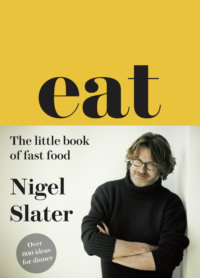
Полная версия
The Kitchen Diaries II
A strong, long-bladed implement is the only way to gain entry to tough-skinned squashes such as the winter pumpkins, though I have been known to take a garden axe to the odd Crown Prince variety. You need a strong blade to get through celeriac too, and sometimes the larger, end-of-season swede. A serrated bread knife might just stand in its stead, but it is rarely man enough for the job.
I brought the 20cm cook’s knife back from Japan a while ago. It is the tool I use for slicing vegetables, chopping herbs, dicing meat. I know every nick and stain on its blade. It seems inappropriate to say that the right knife is like a comfort blanket, you feel safe with it in your hand, but that is how it is.
I do, though, find it mildly disturbing to find comfort in something with which you could so easily kill someone.
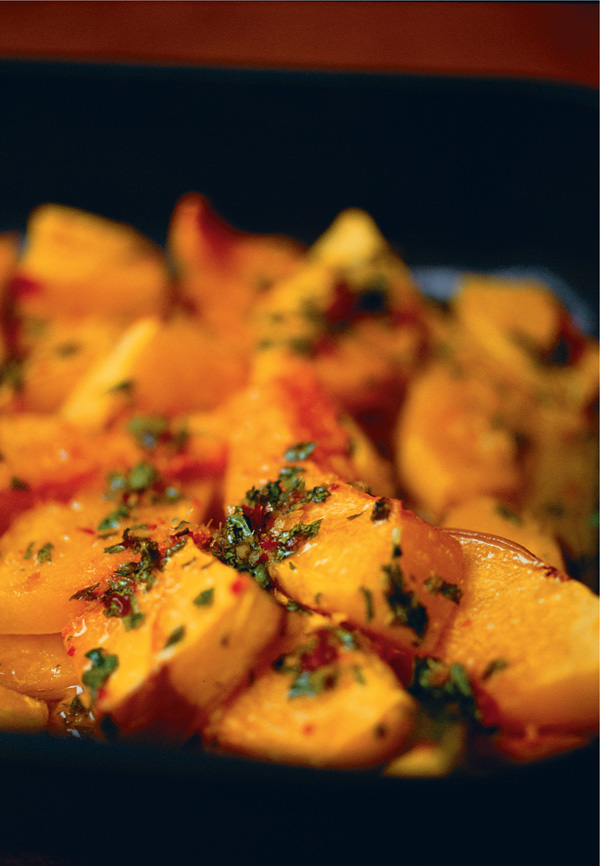
Hot, sweet baked pumpkin
Initially, this was a side dish to go with a flash-fried steak. But its sticky, sweet-sharp qualities led me to serve it as a dish in its own right. In which case there is a need for a dish of steamed brown rice to go with it. This is a genuinely interesting way to combat the sugary, monotonous note of the pumpkin. The colours are ravishing.
pumpkin or butternut squash: 1.5 kg (unpeeled weight)
butter: 50g
For the dressing:
caster sugar: 4 tablespoons
water: 200ml
ginger: a thumb-sized lump
large, medium-hot red chilli: 1 limes: 2
fish sauce: 2 capfuls
coriander: a small bunch, finely chopped
Set the oven at 200°C/Gas 6. Peel the pumpkin, discard the seeds and fibres and cut the flesh into small pieces about 3cm in diameter. Put them in a roasting tin with the butter and bake for about an hour, turning them occasionally, till soft enough to take the point of a knife. They should be completely tender.
Put the sugar and water in a shallow pan and bring to the boil. Turn the heat down and leave to simmer enthusiastically till the liquid has reduced by about half. Meanwhile, peel and roughly chop the ginger and put it in a food processor. Halve the chilli lengthways and chop roughly, removing the seeds if you wish for a less spicy seasoning (I tend to leave them in for this recipe). Add the chilli to the ginger, then grate in the zest of the limes. Squeeze in the juice from the limes, then process everything to a coarse paste, pushing the mixture down the sides of the bowl from time to time with a spatula.
Stir the spice mixture into the sugar syrup and continue simmering for a minute. Add the fish sauce and coriander and remove from the heat.
When the pumpkin is fully tender, spoon most of the chilli sauce over it, toss gently to coat each piece, then return to the oven for five to ten minutes. Toss with the remaining dressing and serve.
Enough for 6 as a side dish
JANUARY 15
A slow-cooked bean hotpot. And a quick version
A dry day, warm enough to garden without a jacket. The earth, dark and moist from the week’s rain, crumbles in textbook fashion under the garden fork. There is still a scattering of bronze leaves and here and there the odd medlar that melts in your hand, leaving behind the ghost of wine dregs in a glass. Anyone with a scrap of land will value January days like these for getting the earth turned, roses pruned and stray leaves collected.
I spend a couple of hours tugging out the last of the borlotti beans, their dried stems still twisted around the hazel poles. This should have been done in December and both the bean stems and precious hazel supports snap like icicles. The odd purple-skinned potato and (useless) radish come to the surface as I fork the soil. Before I go in, I move a patch of soggy brown leaves from under the medlar tree and find three rhubarb tips poking teasingly through the soil. Their carmine rudeness against the chocolate-brown soil at first startles, then delights.
Technology excites me (be it Japanese Shinkansen trains or the next thing that Apple throws our way) but so does the celebration of slow, time-honoured rituals. The way of living that hasn’t changed in centuries. Houses built or restored using traditional methods, treading grapes to make wine (yes, a tiny number of vineyards still do it) and anything hand made. Last night I soaked beans for a hotpot. I could have opened a can of course, and sometimes I do, but the idea of doing something just as it has been done for thousands of years appeals to me. So I soak them, a mixture of small white haricot and black-eyed beans. You can soak different varieties of bean together if they are the sort that enjoy the same cooking time (long, oval flageolet take less than the rounder beans). Covering the beans with an equal volume of water is usually enough. But they should be drained and rinsed the following day. This will effectively reduce the oligosaccharides, those complex, indigestible sugars that make us fart. More importantly, it cuts down the cooking time.
A crisp-crusted hotpot of aubergines and beans
If you haven’t soaked beans the night before, or simply can’t be bothered, then use canned haricot or black-eyed beans for this. You will need three 400g cans, drained and rinsed.
dried haricot or black-eyed beans: 450g
bay leaves: 2
aubergines: 2 (about 500g in total)
olive oil
onions: 2
garlic: 3 cloves
rosemary: 3 stems
dried oregano: 1 tablespoon
chopped tomatoes: two 400g cans
For the crust:
white bread, not too crusty: 125g
a clove of garlic, peeled and crushed
grated Parmesan: 30g
a lemon
rosemary: 2 or 3 sprigs
dried oregano: 1 teaspoon
olive oil: 3 tablespoons
Put the beans into a deep bowl, cover with cold water and leave overnight. In the morning, drain off any remaining water, rinse the beans, then tip them into a large saucepan and cover with at least 2 litres of water. Bring to the boil, then skim off the froth that rises to the surface. Lower the heat to a jolly simmer, add the bay leaves and partially cover the pan with a lid. Leave the beans to cook for forty-five minutes, till almost tender. They should give a little when squeezed between finger and thumb. Drain the beans and set aside.
Cut the aubergines in half lengthways, then cut each half into about 8 thick slices. Warm 4 tablespoons of olive oil in a casserole. Fry the aubergines, in two or three batches, till pale gold on both sides and soft in the middle, then remove and drain on kitchen paper. Add more oil to the pan and lower the heat as necessary for each batch. The pieces of aubergine must be soft and tender.
Set the oven at 200°C/Gas 6. Peel and roughly chop the onions. Add to the empty casserole with a tablespoon or two of olive oil and leave over a moderate heat till they have softened. While the onions are cooking, peel and thinly slice the garlic and finely chop the needles from the rosemary stems. Add to the onions with the oregano and leave to soften. The onions shouldn’t colour.
Add the tomatoes to the onions and garlic and bring to the boil, then stir in the drained beans and the aubergines. Fill an empty tomato can with water and pour it into the pan. Once the mixture has returned to the boil, turn off the heat. Cover the pan, transfer to the oven and bake for 45 minutes.
Make the crust by reducing the bread to coarse crumbs in a food processor. Add the garlic and the Parmesan cheese, then season with black pepper and a little salt. Finely grate the lemon zest and add it to the crumbs. Remove the rosemary needles from their stems and chop them finely. Stir into the crumbs with the dried oregano. Pour the olive oil into the breadcrumbs and toss gently; you want them to be lightly moist.
Remove the bean dish from the oven and spoon the crumbs on top. Return to the oven, uncovered, and bake for twenty to twenty-five minutes or until the crust is crisp and the colour of a biscuit.
Enough for 4
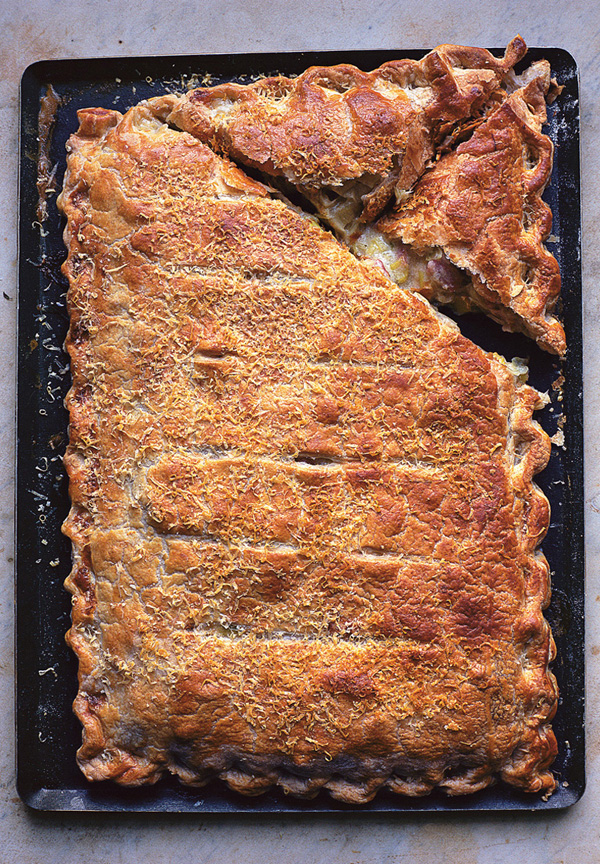
JANUARY 18
Cheating with puff pastry
There are two ways of making a savoury puff pastry crust. I sometimes take a quiet afternoon to blend flour and butter and roll, fold, chill, roll and roll again. With Radio 4 on in the background, making puff or rough puff pastry is as much therapy as cooking. I use the ready-made stuff from the freezer, too. It’s a cop out, a cheat, but really, who cares? The brands made with butter have a good flavour, are crisp and light and often, helpfully, come ready rolled into sheets. It means I can have a pie such as tonight’s chicken and leek without making my own pastry.
A hearty pie of chicken and leeks
chicken thighs on the bone: 350g
chicken breasts: 350g
half an onion
peppercorns: 8
a bay leaf
milk, to cover
butter: 30g
smoked streaky bacon: 6 rashers
leeks: 2 medium
plain flour: 3 lightly heaped tablespoons
Dijon mustard: 3 teaspoons
puff pastry: a 375g sheet
a little beaten egg and milk
grated Parmesan
Put the chicken pieces into a large saucepan, together with the half onion, peppercorns, bay leaf and enough milk just to cover the chicken. Bring to the boil, then, just when it starts to bubble, lower the heat and leave to simmer, partially covered by a lid, for twenty minutes. Remove the chicken, reserving the milk, and pull the meat from the bones. Cut it into small, plump pieces.
Set the oven at 200°C/Gas 6. Melt the butter in a large saucepan, add the bacon, cut into small pieces, and let it soften without colouring over a moderate to low heat. Slice the leeks into pieces roughly 1cm thick. Wash them very thoroughly, then add them to the bacon and continue cooking for about fifteen minutes, till they are totally soft.
Stir the flour into the leek and bacon, continue cooking for a couple of minutes, then gradually strain in enough of the warm milk to make a thick sauce. Fold in the chicken and check the seasoning, adding the mustard and a generous grinding of salt and pepper.
Roll one half of the pastry out into a rectangle 27cm x 37cm and transfer it to a baking sheet. Spoon the filling on to the pastry, leaving a wide rim all the way round. Brush the rim with beaten egg and milk. Roll out the second piece of pastry to the same size as the base and lower it over the filling. Press and crimp the edges together firmly to seal them. It is worth making certain the edges are tightly sealed, otherwise the filling may leak.
Brush the pastry all over with the beaten egg wash and scatter a handful of grated Parmesan over the surface. Bake for thirty-five minutes or till golden.
Enough for 6
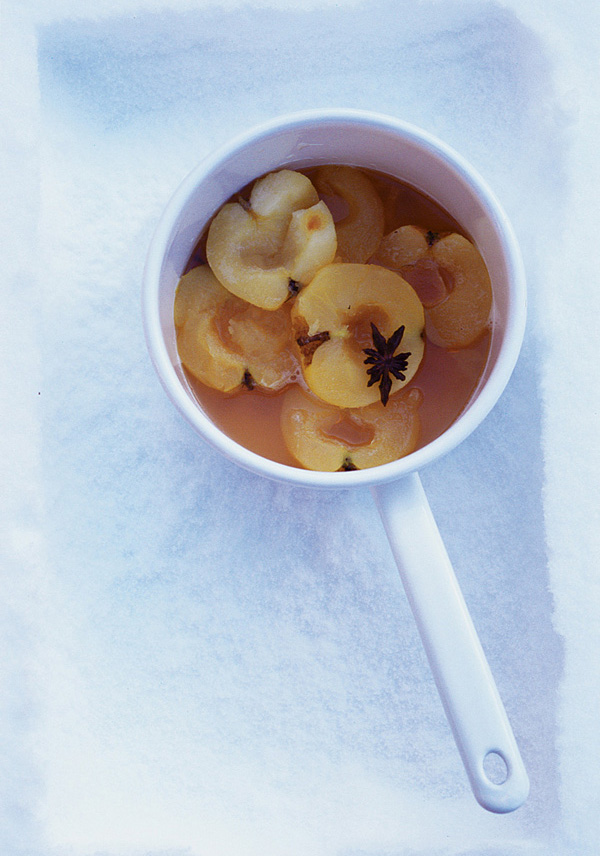
Poached apples with ginger and anise
Warm apples in a gently spiced syrup are useful as both a breakfast dish and a dessert. Sweet but refreshing, and pleasingly simple, these poached fruits are also good served thoroughly chilled. A nice change from creamy desserts. Odd as it seems, we ate this outside in the snow. The ginger-scented warmth and clarity of the juice encouraged us to eat it standing up in the garden, marvelling at the tall hedges weighed down with snow and the slowly darkening sky.
small to medium dessert apples: 3
the juice of half a lemon
unfiltered apple juice: 400ml
golden caster sugar: 2 tablespoons
star anise: 2
ginger preserved in syrup: 40g
syrup from the ginger jar: 4 tablespoons
Peel the apples, halve them and remove their cores. Toss gently in the lemon juice. Pour the apple juice into a pan large enough to accommodate the apples, then add the caster sugar, star anise, the ginger, sliced into coins, and the ginger syrup. Bring to the boil, then lower the heat so the liquid simmers gently.
Lower the fruit into the simmering syrup and leave, partially covered with a lid, until they are tender. They are ready when a skewer will glide effortlessly through their flesh – fifteen to twenty minutes or so.
Lift the fruit from the syrup with a draining spoon and place on a serving dish or in smaller individual dishes. Turn up the heat and bring the syrup to the boil. Serve warm, three halves of fruit per person, in little dishes or glasses with some of the apple- and spice-scented syrup spooned over.
Enough for 3
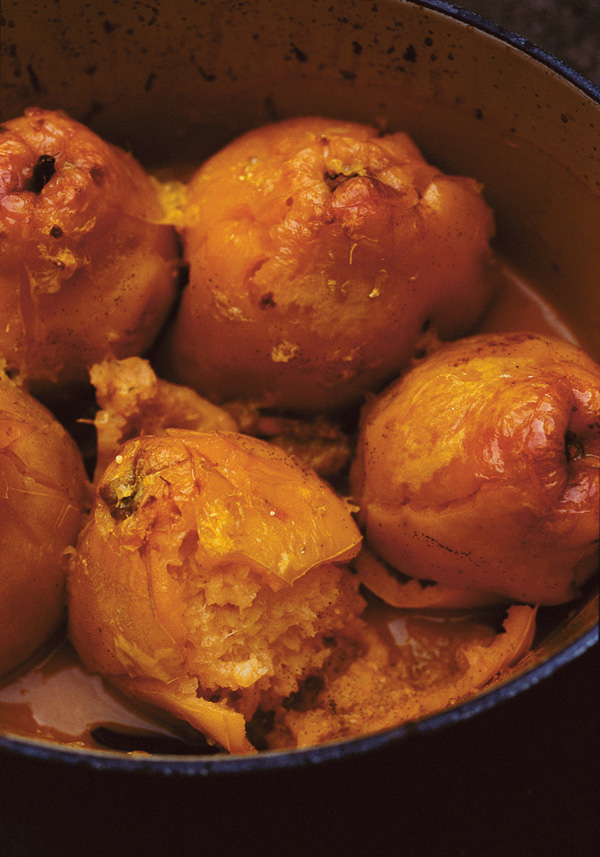
JANUARY 20
A golden fruit
A need for something sweet so I walk along London’s Edgware Road, with its Lebanese grocer’s and pastry shops. On a winter’s afternoon, this road north of Marble Arch is where I go to stock up on what we used to call sweetmeats – the tiny, sugary fruits and pastries that mark the end of a meal. Though I should add that they come out with coffee too, mid morning.
Today there are boxes of darkly sticky dates, powdery lokum, the Turkish delight whose chewy translucency comes scented with rose, pistachio and lemon, and crates of fat, gritty figs. Any of these will signify the full stop at the end of dinner as effectively as a slice of pie (though I would rather have the latter, if I’m honest). There are crimson pomegranates too, lemons on the twig, and tangerines sold with their leaves. There are pale and milky walnuts in their shells, sugared almonds and sultanas the colour of Sauternes.
Today I come back with a small box of honey-soaked pistachio pastries, a bag of fudge-textured dates, some thick, snow-white Lebanese yoghurt and a polystyrene tray of lamb chops the size of a baby’s fist. They will be grilled and dipped into hummus. Almost absentmindedly, I also pick up a handful of golden, pear-shaped quinces.
Despite its delicate fragrance, the quince is a harsh taskmaster. You need a strong wrist and a good knife to get through its hard flesh, and patience to see it cook through to tenderness. Your efforts will be rewarded though. Cooked slowly, this rock-hard fruit will be transformed into one of glowing colour and gently honeyed flavour. If you leave one to simmer with sugar and water, it will eventually turn a deep, translucent crimson.
Just two quinces in an apple pie are enough to imbue the entire filling with their scent and flavour. The quince’s flesh is considerably drier and more grainy than the apple, and needs additional moisture and time in which to cook. I put them on first, adding the apples only once the quince is showing signs of softness. In Tender, I used them in a pickle, a crumble and to sweeten a dish of slow-cooked lamb, but I spent today working them into a pie. Instead of a pastry crust, I have enclosed them in a loose form of crumble, so that the amber fruit shows through.
This tart needs a good hour or more of our time, but is really rather good. Serve it with a jug of cream or a scoop of crème fraîche.
Quince and apple tart
a lemon
quinces: 500g
caster sugar: 2 tablespoons
maple syrup: 3 tablespoons
sweet apples: 750g
For the top:
plain flour: 150g
butter: 75g
demerara sugar: 75g
an egg, lightly beaten
For the crust:
butter: 100g, at room temperature
caster sugar: 80g
an egg, lightly beaten
plain flour: 200g
Make the pastry crust: dice the butter and put into a food mixer or processor with the sugar. Cream till light and fluffy, then add the egg and mix thoroughly. Spoon in the flour, bring the dough into a ball – it will be quite soft – then place on a generously floured work surface or board. Knead briefly; this will make it easier to work. Roll out the dough to fit a 22cm tart tin with a removable base, pushing it carefully into the corners and up the sides, patching any tears as you go. Refrigerate for twenty minutes.
Put a baking sheet in the oven and set it at 200°C/Gas 6. To make the filling, squeeze the lemon into a mixing bowl. Peel and core the quinces, then chop them into small pieces, tossing them in the lemon juice as you go to stop them browning. Place them in a deep saucepan, add the sugar and maple syrup, cover with a lid and leave over a low heat for fifteen minutes, until tender enough for you to insert a metal skewer into them easily. Check regularly and lower the heat if necessary, particularly towards the end of cooking when the syrup has reduced.
Meanwhile, core and dice the apples – there is no need to peel them. Stir them into the quinces as soon as the quinces are almost tender. Continue cooking, covered, for five to ten minutes or until the apples are just soft. Set aside.
Make the topping: put the flour and butter into a food processor and blitz till they resemble fine breadcrumbs. Alternatively, rub the butter into the flour with your fingers. Add the sugar and the egg and mix briefly to a moist, crumbly texture.
Fill the uncooked tart case with the apple and quince mixture, setting aside any juice, then scatter the crumble topping over. Some of the fruit will show through. Lift on to the hot baking sheet and bake for thirty minutes, till the crust and pastry are crisp and golden. Allow to settle a little before serving with a trickle of the reserved juices and some cream or crème fraîche.
Enough for 6–8
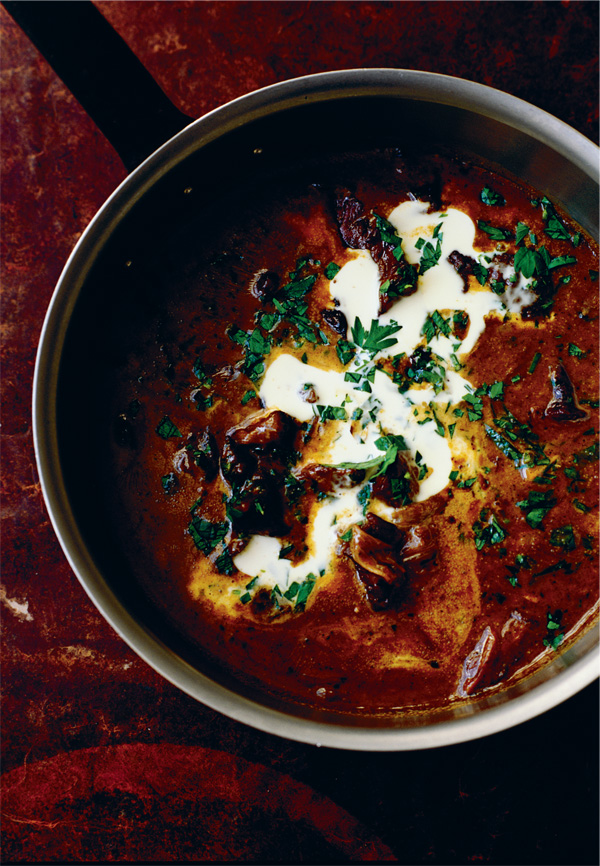
JANUARY 21
Browning meat. More quinces
Putting a piece of meat into a shallow layer of sizzling-hot fat, butter, duck fat, dripping or oil will do wonders for its flavour. Whilst it won’t actually ‘seal in’ the juices, as is often suggested, getting the cut surfaces of the meat to brown will enrich both the flavour of the meat and, rather importantly, the juices in the pan. It is worth doing. But here’s the rub. The meat must be given time to brown properly, and that means we need to leave it alone. I have lost count of the number of times I have seen meat, particularly beef, moved constantly round with a spoon or spatula. Hard as it is not to tinker, we must leave it alone long enough for the cut surfaces to colour appetisingly, otherwise the action is pointless.
Quick, mildly spiced beef
rapeseed oil
cubed beef (e.g. chuck steak): 500g
onions: 2 large
garlic: 3 cloves
ground cumin: 2 teaspoons
ground coriander: 2 teaspoons
garam masala: 1 tablespoon
vegetable or beef stock: 500ml
grain mustard: a tablespoon
double cream: 200ml
Warm a little oil in a heavy, shallow casserole. Season the beef with salt and black pepper, then colour on all sides in the oil, turning only occasionally. Remove from the pan with a draining spoon.
Meanwhile, halve, peel and thinly slice the onions. Peel and thinly slice the garlic. Add the onions and garlic to the pan, letting them soften a little but not brown beyond pale honey colour. Stir in the ground cumin, coriander and garam masala, then continue cooking for five minutes before returning the meat and any juices to the pan. Pour in the stock, bring to the boil and simmer for ten minutes, till the liquid has reduced by half.
Stir in the mustard, pour in the cream and bring to the boil. Check the seasoning and serve.
Enough for 4
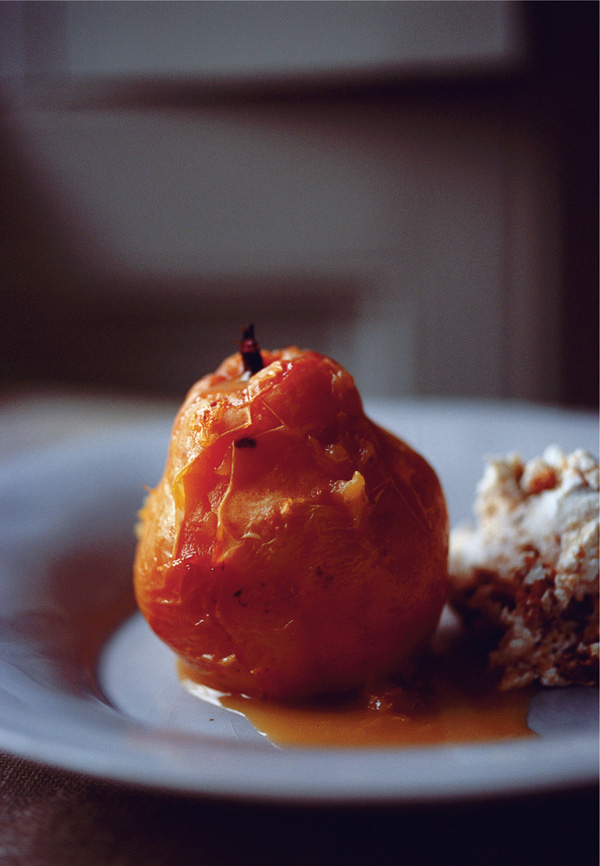
Baked quince with orange and mascarpone ginger crunch
The quince once seemed so impenetrable. Mentions of membrillo and quince liqueur did nothing to invite entry to the rock-hard, yellow fruit that resembled a dumpy papaya. Ten years on, I take a deep casserole from the oven, the five fruits split, their soft, almost fluffy, pink flesh peeping through, and marvel at their beauty. There is orange in there too, vanilla in its sticky pod and a single cinnamon stick. The steam beguiles and amuses with its notes of amber, orange blossom and spice. The quince has come a long way in this kitchen. I guess we all have.
quinces: 4 large
oranges: 3
a cinnamon stick
a vanilla pod
For the mascarpone ginger crunch:
ginger biscuits: 75g
mascarpone: 200g
Set the oven at 200°C/Gas 6. Put the quinces in a deep casserole, piercing them here and there with a small knife or skewer as you go.
Halve and juice the oranges and pour into the casserole, add the cinnamon stick and vanilla pod and then cover with a lid. Bake for an hour or so, till the skins have wrinkled and the flesh is tender to the point of a knife.
For the ginger crunch, crush the biscuits, either in a plastic bag with a rolling pin or in a food processor, but not too finely. They should have a mixture of textures from gravel to coarse sand. Fold the biscuits into the mascarpone.
Remove the quinces from the juice, place on small plates and serve with the pan juices and the mascarpone ginger crunch.
Enough for 4
JANUARY 22
A potato crust for a fish pie…
I do love a fish pie, with its flaky, undulating pastry crust or deep, furrowed lid of mashed potatoes crisped in the oven. For an everyday fish pie, the sort I might make for a midweek supper, I take a shortcut with the crust, using breadcrumbs and herbs blitzed in the food processor or thin slices of potato. That way I get a crisp lid as a contrast to the softness underneath without having to make and roll pastry. When time is of less importance, at the weekend, say, I use a more traditional crust of butter and flour or potatoes whipped up with parsley and butter to contrast with the deep, creamy, piscine filling.
Which fish I use for a pie will change according to supply, whim and conscience. Fish is rarely a cheap eat, but we can trim the bill a little by choosing the less popular varieties such as ling and whiting and, if it is to our taste, coley (try as I might, I can’t find much excitement in a piece of coley). A sustainable alternative to the knee-jerk varieties is crucial and I have had much success with pollack and line-caught haddock. I’m getting used to gurnard too, a bit of an ugly bugger but with a reasonable flavour. A firm-textured fish once used as lobster bait and now appearing on menus everywhere, from Moro to Rick Stein’s restaurants in Padstow, the gurnard responded well to being baked with cream and basil. I introduced a potato top, neat slices laid one overlapping the next, a way of padding out a few fish fillets to make them go a bit further. It’s a sweet and gentle pie, without the stodge of one crowned with mashed potatoes (good though they can be). Something to serve with steamed purple sprouting broccoli or the salad that follows.
Gurnard, basil and potato pie









